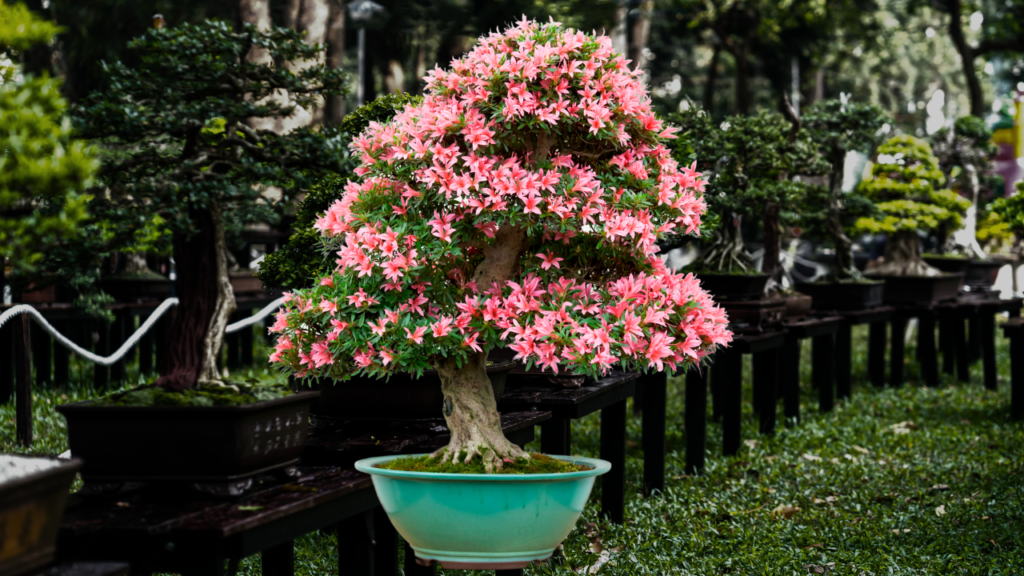Azaleas, with their stunning blooms and vibrant colors, are a prized choice for bonsai enthusiasts. Their ability to produce a spectacular floral display, combined with their adaptability to bonsai cultivation, makes them a favorite among many. Here’s a detailed care guide tailored for Azalea bonsai:
| Azalea Bonsai Quick Reference | |
|---|---|
| Attribute | Information |
| 🌾Plant Type | Evergreen shrub |
| 📏Mature Size | Varies depending on species and cultivation; typically much smaller when cultivated as bonsai |
| ☀️Sun Exposure | Thrives in a sunny spot, but requires shade during the hottest time of the day in summer |
| ✂️Pruning | Pruning should be timed well to ensure abundant flowering |
| 🎭Common Bonsai Styles | Various styles depending on cultivar and artist’s preference |
| 🌼Bloom Time | Late Spring |
| 🍂Leaf Characteristics | Dark green leaves that vary in size and shape depending on the cultivar |
| ❄️Hardiness | Should be protected from temperatures below 40° F (-5° C) |
| 🌎Native Area | Varies by species |
1. Positioning and Light:
- Sunlight: Azaleas prefer bright, indirect sunlight. While they need good light to bloom, direct midday sun can scorch their delicate leaves. Morning sunlight and afternoon shade are ideal.
- Outdoor Living: Azaleas benefit from being kept outdoors, especially during their blooming season. However, they should be protected from strong winds and extreme temperatures.
2. Watering:
- Frequency: Azaleas prefer consistently moist soil. Water when the top layer of soil starts to feel dry, ensuring that the soil never dries out completely.
- Method: Use a gentle watering technique, ensuring the entire root ball is moistened. Allow excess water to drain from the pot to prevent root rot.
3. Humidity:
- Azaleas appreciate higher humidity, especially during hot summers. Consider placing a humidity tray beneath the pot or misting the foliage occasionally.
4. Soil and Fertilizing:
- Soil: Azaleas require acidic soil. A mix of kanuma (a type of acidic volcanic soil), pine bark, and sphagnum moss is ideal.
- Fertilizing: After the blooming season, feed your Azalea bonsai every two weeks with an acid-forming, balanced liquid fertilizer. Avoid fertilizing while the tree is in bloom.
5. Pruning and Shaping:
- Pruning: Regular pruning helps maintain the tree’s shape and promotes more blooms. Trim back new growth after flowering. Remove dead or weak branches to allow more light and air circulation.
- Wiring: Azaleas have delicate branches, so care should be taken when wiring. It’s best to wire in late winter or early spring before the blooming season.
6. Repotting:
- Azalea bonsai should be repotted every 2-3 years. The best time is after the blooming season, usually in late spring or early summer.
- Gently trim the outer roots during repotting to encourage a healthy root system.
7. Pests and Diseases:
- Azaleas can be susceptible to lace bugs, aphids, and fungal diseases like petal blight. Regularly inspect your tree and treat any issues promptly using appropriate treatments.
8. Winter Care:
- While many Azalea species are cold-hardy, they should be protected from extreme cold and frost. Consider placing them in a cold frame or sheltered spot during harsh winter months.
9. Blooming Tips:
- To encourage a profuse bloom, ensure your Azalea gets adequate light throughout the year.
- Remove spent flowers to promote more blooms and prevent seed formation, which can drain the tree’s energy.
Bonsai Care Essentials
Conclusion:
Azalea bonsai trees are a celebration of nature’s beauty, offering a mesmerizing display of colors and blooms. With attentive care, the right environment, and a passion for the art, your Azalea bonsai will be a radiant spectacle, capturing the essence of spring in miniature.
